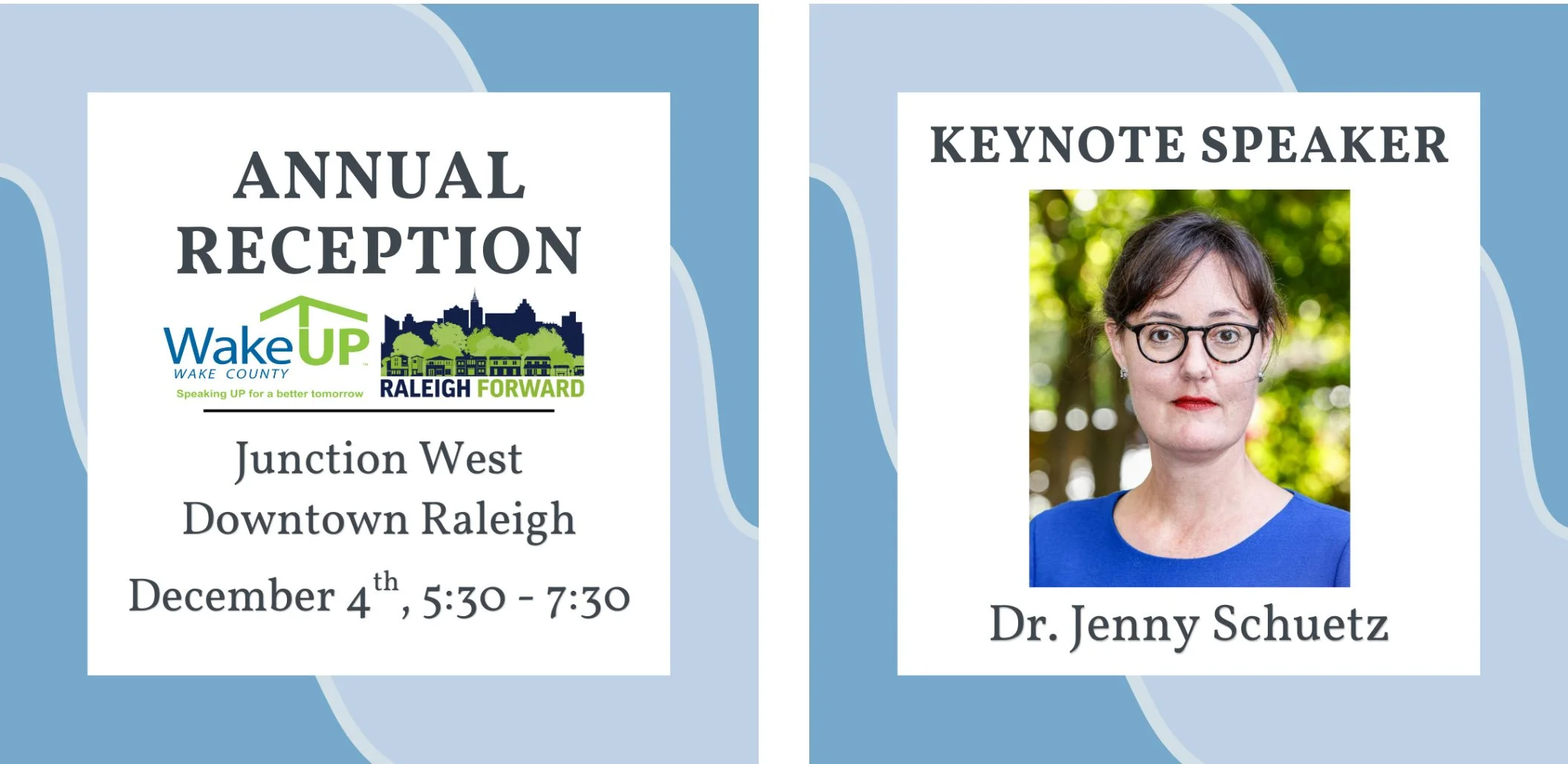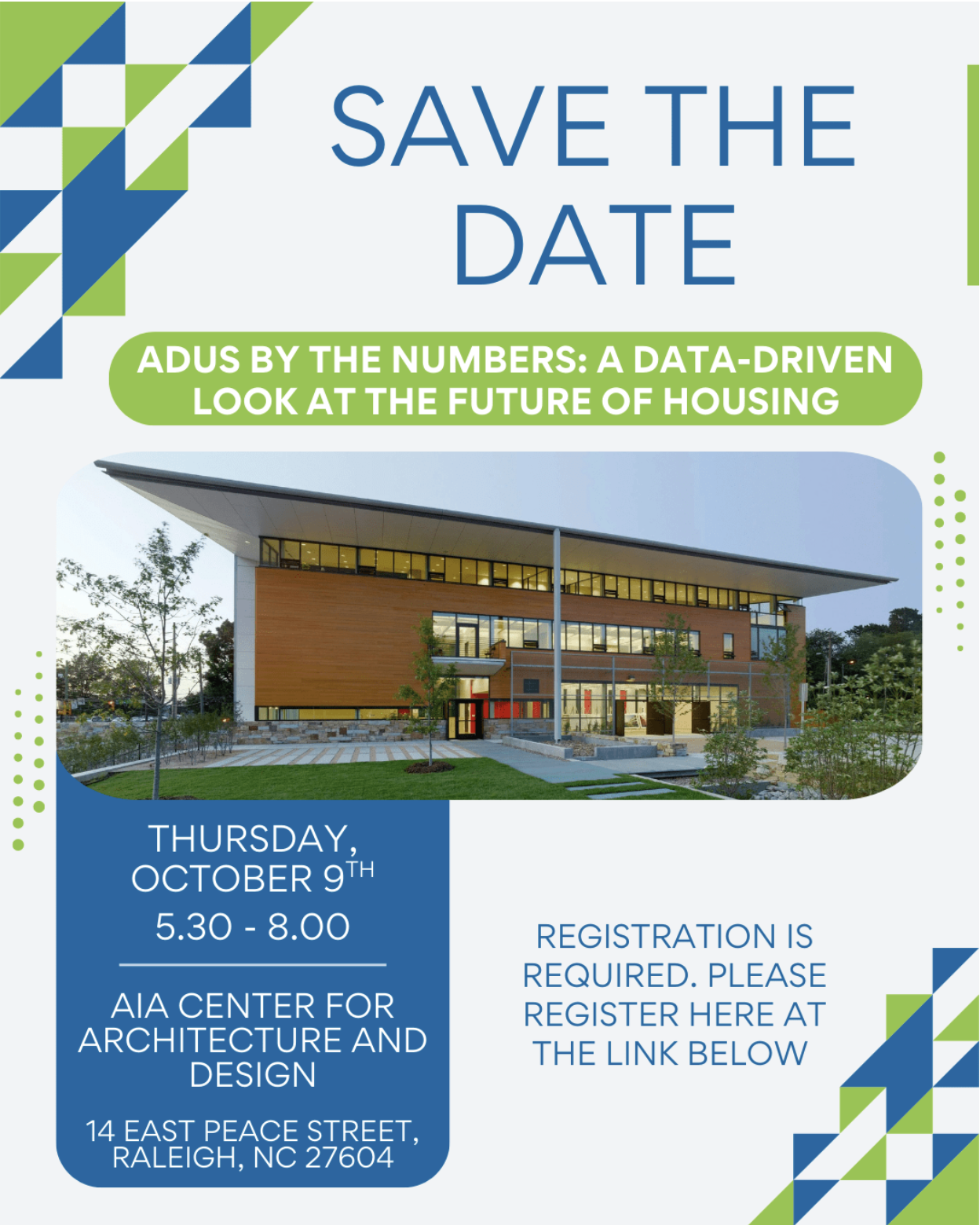October 5, 2025 Newsletter
To receive these updates directly to your inbox, subscribe on Substack.
Save the Date: Annual Reception with WakeUP Wake County on December 4th
Featuring Keynote Speaker Dr. Jenny Schuetz, a prolific writer on housing markets and author of the book, Fixer Upper: How to Repair America’s Broken Housing Systems.
Support Our Mission
If you are interested in sponsoring our joint Annual Reception with WakeUP Wake County, please reach out to us directly!
If you appreciate the newsletters, articles, policy briefs and events that RaleighForward puts together, please consider making a donation today.
We are proud to provide this content free-of-charge. Your support makes this work possible and will empower us to do even more in the near future.
ADUs by the Numbers Event
Council held its mid-year retreat on Saturday, September 27.
Click here to watch a video replay of the event.
The agenda included these 5 topics (click each link below for staff presentations and agenda backup material):
Each of these retreat topics are important. However, current circumstances related to Federal and State funding reductions, along with persistent budget uncertainty, heightens the importance of the bond financing discussion and Council’s discussion of the City’s financial outlook. As the City’s budget comes under increasing pressure, funding items beyond basic services like police, fire, roads, water, sewer, etc., becomes more difficult.
During the retreat discussion, it was clear that City leaders understand that Raleigh must find ways to do more with less financial assistance from Congress and the NC General Assembly. Considering this new budgetary reality, Council must position the City to take advantage of every opportunity to leverage its local financial tools, particularly real estate taxes and bond financing.
As RaleighForward has emphasized this year, to remain vibrant and fiscally sound, Council must secure the City’s financial position by embracing higher density, mixed-use development near existing integrated mixed-use centers like North Hills, Downtown/inside the Beltline, Brier Creek, Downtown South and The Village District. Because Raleigh has very limited undeveloped land left, it must adopt policies and approve rezonings to ensure residents looking to move to Raleigh have a diverse and growing supply of housing options to choose from.
For those interested in exploring this issue further, here are a few recent RaleighForward newsletter articles and other sources:
Articles and Resources of interest:
Policy Brief #1: Understanding, Transportation, and Inequality Trends through Spatial Analysis
Continuing Discussion about Why Density Matters for Raleigh’s Fiscal Future
Letter to the editor from Founder Eric Braun: Raleigh’s future
Op-ed from Founder Eric Braun: Raleigh reforms fill housing’s ‘missing middle’
Scenario modeling shows more compact allocations reduce municipal servicing needs (roads, water/sewer) and related costs versus status-quo dispersion, with co-benefits for GHG and health. Though Canadian, methods and cost drivers (network length per capita, service catchments) generalize to U.S. cities.
EPA (2014) — Smart Growth and Economic Success: Strategies for Local Governments
Concise federal guidance summarizing evidence that compact, infill development lowers per-capita costs for water, sewer, and roads and reduces ongoing expenses (police, fire/EMS, street maintenance, solid waste) compared with dispersed growth. Includes implementation strategies for fiscally minded localities.
Urban3 for Nashville-Davidson (2013) — Revenue Productivity & Fiscal Scenarios
City-commissioned analyses show downtown, mixed-use smart-growth projects dramatically outperform suburban projects on net fiscal return (e.g., far higher surplus per acre/unit). Reinforces “value-per-acre” as a practical metric for municipal solvency and capital planning.
Urban3 (case studies, e.g., Minneapolis) — Value-per-Acre Analyses
City-sponsored revenue models visualize taxable value per acre: walkable, mixed-use cores generate steep “spikes” of fiscal productivity, while auto-oriented, low-density areas underperform on a per-acre basis. Useful, reproducible framing for linking land use to recurring revenues.
Litman (2025), VTPI — Understanding Smart Growth Savings (synthesis)
A recent methodological synthesis: compact development typically cuts public infrastructure construction costs by ~⅓ and ongoing public-service costs by ~10%, echoing multi-study findings (including SGA 2013). Also quantifies how reducing sprawl rankings lowers per-capita expenditures.
From the Data Department:
Wake County Register of Deeds: The median price of Wake County real estate dropped by $24,750 to $460,000
Items of Interest in the Week Ahead:
Raleigh City Council begins meeting again October 7th. Here are some items of interest:
Council will decide on a proposal to create a new social district at Seaboard Station.
A proposed amendment to the City’s noise ordinance will be considered by Council. Addressing noise related to nightlife in Glenwood South continues to be a challenge for residents and the City.
Staff will present a plan for administering a Citizen Assembly as an engagement tool for developing Raleigh’s next Comprehensive Plan. As readers of the RaleighForward Newsletter know, we have been advocating for the City to use citizen assemblies as an engagement tool. In March, RaleighForward and WakeUp Wake County hosted an event with the City of Raleigh and the National Civic League called “Emerging Community Engagement Tools.” This will be the City’s first (but hopefully not last) use of citizen assembly. RaleighForward is excited that the City selected the National Civic League as its partner in implementing Raleigh’s first citizen assembly.
The Planning Director will give Council an overview of the City’s development review process. It is great to see that Council is interested in better understanding this important process most new projects must navigate.
Council’s Special Committee on Boards and Commissions will present additional information and possible consolidation of some of the City’s numerous boards and commissions. Specifically, the recommendation is to dissolve the Community Engagement Board and consolidate the Hispanic and Immigrant Affairs Board and the African American Affairs Board into the existing Human Relations Commission.
There is a rezoning public hearing for an assemblage located at the intersection of Peace and West Street adjacent to the City’s proposed Smokey Hollow Park. Rezoning case Z-12-25 involves approximately 2.6 acres and seeks to go from Industrial Mixed-Use 12-stories to Downtown Mixed-Use 30-stories with conditions. Proposed conditions include the payment of $1,200,000 into the City’s affordable housing fund, restrictions on the height of certain buildings, building materials and mandatory connections to the proposed Smokey Hollow Park. After the public hearing, Council may vote on the case, place it into a committee for additional review or hold it at the table until a future meeting. This case is generating a great amount of public attention because of the proposed intensity of commercial and residential uses. RaleighForward suggests reviewing the information in this Newsletter’s blog post regarding the benefits of increasing density in areas near existing or proposed public transit and public amenities like parks and greenways.
Other items of interest:
Given the fiscal challenges facing many cities as Federal and State governments cut back on assistance to local governments, Raleigh is taking a proactive approach by starting listening sessions for residents across the City. For details and how to participate, click here.


